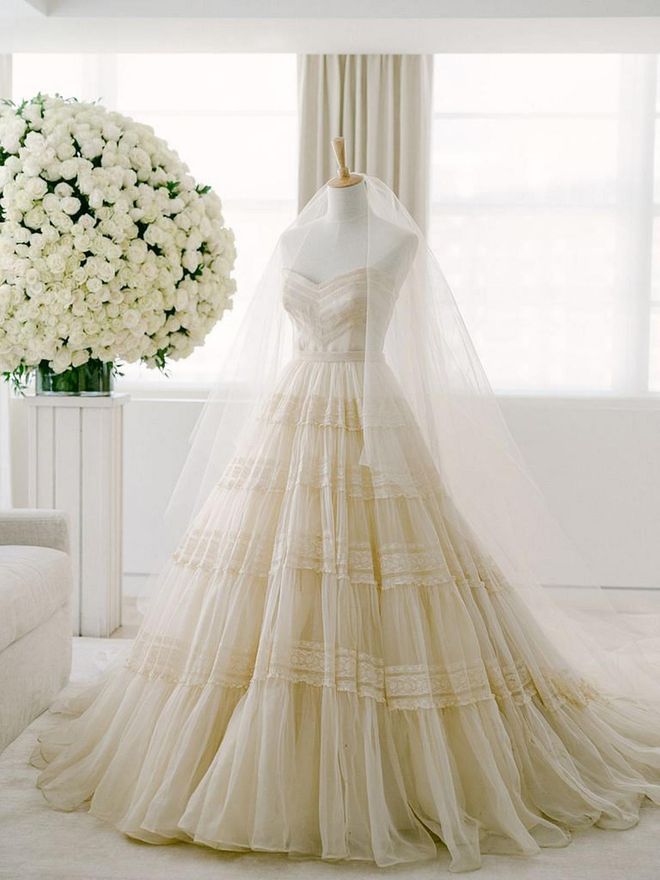Everything You Need To Know About Preserving Your Wedding Dress—Straight from the Experts
All your questions asked—and answered—for the wedding and beyond.

A wedding dress is likely to be the most sentimental purchase a woman will make in her lifetime—if not one of them. These gowns are regarded as heirlooms, regardless of the financial investment; and if you're considering passing it down one day for a future generation to wear as-is or utilize elements of, it should be preserved as a keepsake.
Consider a future daughter, daughter-in-law, or family member who may want to wear your wedding dress one day, sew a piece of it into their own, or design a christening gown made of your vintage lace or silk. The wear and tear of delicate fabrics stored improperly runs the risk of an ivory or blush gown yellowing; and exposes fabrics, embroidery, and the details of your dress to the elements.
To give us some insight into the process of preserving your wedding gown for decades to come, we tapped two of the industry's most notable cleaners and preservationists on how to care for your gown right now and post-wedding. Here, everything you need to know about preserving your wedding dress—straight from the pros.
Related article: How To Nail It: Neo-Rustic Wedding Decor

Photo: KT Merry
WHAT'S THE DIFFERENCE BETWEEN STANDARD DRY CLEANING AND GOWN PRESERVATION?
Dry cleaning and preservation are two entirely separate processes. If you're wondering why you can't just have your wedding dress professionally cleaned after the wedding and expect it to hold up years later, it's simply because you're missing an entire step. "Dry cleaning is the treatment of areas, where soiled, with chemicals, explains Karen Jean-Aimee, Bridal Specialist for Madame Paulette. "Once [the] gown is clean, we wrap the dress in acid-free tissue paper and place it in an acid-free archival preservation chamber." Preserving your gown is the proper and appropriate way to care for your dress post-wedding, given that it places the gown, once cleaned, in a safe, waterproof place for long-term storage.
Related article: How To Find The Right Bra Size And Fit
WHEN SHOULD ONE PRESERVE THEIR WEDDING GOWN? HOW LONG IS TOO LONG TO WAIT?
The longer you wait, the more likely sunlight and oxidation can cause damage. "Stains and soils react with textile fibers and over time cause oxidation of the yarns, thus altering the chemistry of the textile and potentially making it much more difficult to reverse the damage safely," says Jonathan Scheer, Founder & CEO of J. Scheer & Co. "Keeping the gown in a cool, dark, dry storage environment after the wedding and before cleaning will slow the process of oxidation and allow for a wider window of opportunity to wait before cleaning," he advises. "I would prefer to see the gown as soon after the wedding as is practical, and advise clients not to wait more than three to six months."
It's important to note that not all stains are visible right away. The fabrics that compose wedding dresses attract impurities easily and it's best to plan your preservation sooner rather than later. Remember that sugar alcohols (wine) and chloride salts will aggressively degrade fabrics and even if you think you cleaned it yourself, and the stains will set and could result in permanent damage.
Related article: How To Refuel Your Body And Feel Energised

Eunice Kennedy Shriver’s 67-year old Dior wedding gown, worn by her grandmother in 1953. (Photo: KT Merry)
DO CERTAIN FABRICS AND EMBELLISHMENTS PRESERVE BETTER THAN OTHERS?
Yes—and each fabrication has its own pros and cons. Wedding dresses are most commonly composed of silk, synthetics, and non-woven embellishments, like beading. Certain types of beads and rhinestones can be particularly problematic in preservation when they have metal settings. For example, Bugle beads often have a silver foil insert that reflects light. It's a beautiful element on the gown, but given that silver foil is a composite metal and metals are inherently unstable, they can cause issues in preservation. "Chemically, they oxidize at a reasonably rapid rate and that oxidation causes discoloration," explains Scheer. "Each setting will oxidize at a different rate, and there's no way to predict which will do so more quickly." If you're looking to pass down a beaded gown, keep in mind that beading and embroideries without metal settings will maintain chemical and structural soundness longer.
Related article: EIC Kenneth Goh How To Look Fabulous Barefaced

On left: A silk veil preserved vs. left unpreserved; On right: silk disintegration in-process. (Photo: Madame Paulette)
Silk is an organic protein fabric, primarily made of fibroin; Like us, this natural fiber will also deteriorate over time. Silk is particularly susceptible to stains and damage from heat and light. "Silk turns shades of brown before disintegrating—it's also biodegradable," says Jean-Aimee. "Have you ever had a favorite silk blouse, and over time, the underarms began to turn yellow? This is exactly what happens to silk. It will begin to turn ivory, then cream, then tan, and shortly after, brown—before the fibers begin to break down," she says. Having your dress properly cleaned and stored is the best way to keep natural fabrics safe and from changing color. When treated well, even if the silk does shift in hue over time, it can acquire the most lovely patina.
Polyester and synthetics fabrics will always retain their color—or at least they should. Synthetics are more stable; they're unnatural, and so their coloring and fabrication are more consistent, but if you're considering dying anything synthetic, don't. Polyester won't accept dye at all. "These fabrics all dye at different rates so you'll get distortion, and they shrink at different speeds, too," reminds Scheer.
Related article: How To Get Rid Of Forehead Wrinkles (Yes, It’s Possible)
WHAT DOES PRESERVATION COST?
Depending on the amount of damage done to the dress on the wedding day, how it's been stored up until the preservation process begins, and the level of intricacy of the gown will determine the cost of preserving a garment. "Our most expensive assignments are typically in the $2,000 to $2,500 range," says Scheer. "This price generally applies to fully embellished custom ball gowns with very full, layered skirts and detachable trains," he adds. When choosing a company to perform this important assignment, do your homework and don't be afraid to ask questions. Inquire about training and qualifications; do they warranty their work; are they recommended by couture designers? "It can't hurt to ask your salon for a reference also," says Scheer.

Photo: Getty Images
HOW SHOULD I STORE A PRESERVED WEDDING GOWN?
Your gown will arrive preserved in a pro-approved storage box, but be mindful that even (so-called) "acid-free" cardboard boxes can re-acidify over time. Cardboard absorbs moisture, which will promote the growth of mold and mildew within a storage chamber, so not just any box will do. "We use proprietary boxes that are made of the same material used by The Costume Institute at the Metropolitan Museum of Art in New York City to store their collections of historic costume. We preserve dresses in a completely archival textile storage box made of fluted polypropylene. A chemically inert polymer and a non-absorbent, it provides more complete moisture protection and resists fluctuations in temperature and humidity," says Scheer.
After the preservation packaging process is complete, and your safeguarded garment has been returned to you, keep the box flat and upright. Store your box in a cool, dark, and dry environment, with relative humidity at 50% at all times or where the climate is regulated for normal living conditions. Avoid direct sunlight or heat. "Do not store a gown in an environment that varies in temperature from season to season, such as an attic or basement," says Jean-Aimee. "The atmospheric change from warm to cold could create condensation and have an adverse effect on the preservation process," she adds.
As for checking in on the dress from time to time, the experts suggest opening the box and inspecting the gown regularly in the rare case that sudden stains, element exposure, and more sit too long without treatment. When removing the dress from the box, remember that your skin contains oils and salts that can damage delicate fabrics. Clean your hands and, ideally, use white gloves. Remove the top of the box and carefully unfold the dress, noting the way it was packed.
When preserved correctly, your dress box will never be completely sealed. Sealing traps moisture in the box, promoting mold and mildew growth, which will stain and weaken the fibers of the dress. And when opening a sealed box, the rush of air will rapidly re-oxygenate the chamber, causing fiber deterioration.

Photo: Benjamin Wheeler)
WHERE SHOULD A WEDDING GOWN BE STORED BEFORE BEING WORN?
Keeping the dress in its most pristine condition is always a goal post-purchase—and pandemic times have brought about extra concerns given that many brides have taken on storing their gowns for postponed weddings rather than keeping them in their point-of-purchase to await alterations.
Upon procuring the gown and between alteration sessions, one should never leave a dress, especially one that's heavy with a full skirt or embellishments, to hang for a long period of time. Hanging the gown for long periods without distributing the weight of the skirt will pull and distort the neckline and the length of the dress. Avoiding direct sunlight and exposure to elements that could cause stains or discoloration should be high priority when storing the dress.
As brides are having to hold onto their dress much longer than originally planned before their new wedding date, J. Scheer & Co. shared a helpful video (see above) demonstrating the best way to securely store a wedding dress at home. All that's needed is a clean white sheet, clean towels, and ribbon or twine.
This article originally appeared on Harper’s BAZAAR US.